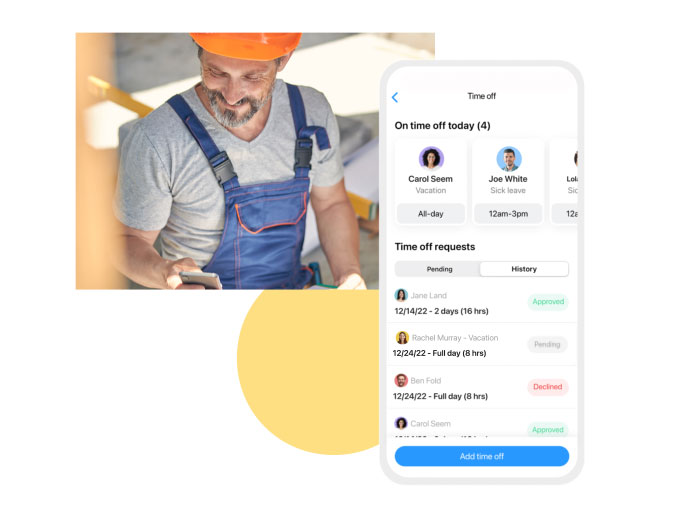Understanding the difference between vacation and paid time off helps you choose the best leave policy for your business.
Table of contents
Taking time off from work is essential for your employees’ well-being. It gives them a chance to switch off and rest, returning to work refreshed and more productive. That’s why most employers offer some paid time off (PTO) even if it isn’t mandatory in the US.
But what leave policy should you use—a general PTO policy or separate policies for different types of leave?
In this article, we answer the question is PTO the same as vacation pay and look at some factors to consider when making decisions around paid leave for your employees.
Is Paid Time Off (PTO) the Same as Vacation?
PTO and vacation leave are both types of employee benefits.
PTO, however, is a broader term than vacation leave. It describes all the types of paid leave an employee can take. Vacation leave is a type of PTO intended for a specific use—to take a break from work for rest and relaxation. Employers that offer paid PTO then compensate their workers with vacation pay.
Some employers offer a single PTO policy—a bank of general PTO days that employees can use as they want for vacation leave, sick leave, personal days, parental leave, jury duty, and volunteer work. Under a general PTO policy, employees typically don’t need to explain their reasons for taking leave.
Employees can accrue PTO based on the number of hours or days they’ve worked. Or they may be banked, where the employee is given their annual allocation of PTO all at once, usually at the start of the year. Some employers offer unlimited PTO.
In contrast, other employers offer separate policies for different types of leave, including vacation leave. Under this approach, each category of leave should be taken for its intended purpose. Like PTO, vacation leave may be accrued or banked.
💡 Pro Tip:
Take advantage of a time off management app like Connecteam to easily manage all things PTO from your desktop, tablet, or phone. Employees can request time off directly from the app and you can track balances, create time off policies, and view all leave requests in one centralized location.

Are PTO and vacation leave mandatory?
Neither paid PTO nor vacation leave is mandatory at the federal or state level in the US.
It’s, therefore, largely up to you as the employer whether you offer your employees a general PTO policy or vacation leave as a separate policy.
Why Offer a General PTO Policy?
Extra flexibility
Some employees prefer the extra flexibility a general PTO policy offers. It gives them the autonomy to decide how they use their leave. This may help you stand out when recruiting and attracting top talent.
Encourages uptake of vacation leave
A general PTO policy may result in employees taking more vacation time and less sick leave. Encouraging employees to use their vacation time is important for their well-being. When employees return from vacation leave, they’re more rested and refreshed than upon returning from sick leave, improving their productivity.
From an employer’s perspective, vacation leave is also more predictable than sick leave and may help you reduce unscheduled absences.
Less administration
A general PTO policy makes it simpler to manage rosters and payroll. As you don’t need to know the reason for taking the leave, you don’t need extra paperwork from your employees to process leave requests. It’s also easier to input the leave in your time management software when there is only one category of leave.
This is especially useful for multi-state businesses. As long as your general PTO policy complies with any relevant state laws, you can offer and administer the same policy to all employees in your organization.
📚 This Might Interest You
Still wondering about the difference between PTO and Sick Time? Read our in-depth guide to learn more.
Easily Manage Time Off Requests in Your Business
Say goodbye to calculators, paper-based calendars, and guesswork with Connecteam’s all-in-one time management software.
Why Offer Separate Vacation Leave?
PTO payouts
Some states require employers to pay employees for any unused vacation leave at the end of their employment. By offering separate policies, you silo each type of leave and limit your potential payout obligations.
For example, if you offered separate vacation and sick leave, then you only need to pay the employee for any unused vacation days and not any sick leave days.
If you offered a general PTO policy that includes vacation leave, you have to pay the employee their balance of any general PTO days. This may be higher, as the pool of PTO days accounts for all types of leave, not just vacation days.
💡 Did You Know?
The US is one of the few countries in the world that doesn’t require employers to offer paid time off. However, most US employers offer employees paid vacation leave as part of their benefits package.
Learn more about the average number of paid vacation days per year US workers get.
Avoids encouraging presenteeism
Under a general PTO policy, employees are responsible for managing their leave allocations. Some may be tempted to use all their days for vacation leave.
If they later fall sick, this may result in them coming to the office unwell and getting others sick. Offering separate leave policies avoids this situation.
Perceived fairness
Some employees may prefer separate leave policies because they view general PTO as unfair. For example, an employee may need to use a significant amount of their general PTO leave to care for their young children when they are sick, reducing the number of days they can take for vacation.
In contrast, employees with no immediate carer responsibilities can use all or most of their PTO on vacation leave.
Tips for Using a General PTO Policy

If you decide to use a general PTO policy, here are a few points to keep in mind.
- Prepare a clear PTO policy, explaining what types of leave it covers. It should also set out how employees earn PTO, any limits on the number of PTO days, what happens to unused PTO at the end of the year or when an employee leaves, how to request PTO, and any limit on the amount of PTO that can be taken at once.
- Communicate your PTO policy to your employees. Employees won’t use their PTO if they don’t know about it. Include it in your onboarding materials for new employees and ensure the policy is accessible on your intranet, your employee handbook, or your employee app.
- Ensure your company culture encourages and supports time off. Time off benefits both the organization and employees. It’s essential that your employees feel comfortable using their leave when they want or need to.
💡 Pro Tip:
Read up on the different PTO payout laws by state so you know what’s legally required of your business.
Then, take advantage of Connecteam’s free PTO policy template to develop a customized company policy that both you and your employees will be happy with.
FAQ
What is PTO?
PTO, or paid time off, is a policy that allows employees to take paid leave for any reason, including vacation, personal days, or illness. It provides flexibility for employees to manage their time off without specifying the reason to their employer.
What is the difference between vacation and personal days?
Vacation days are specifically designated for employees to take time off for leisure and relaxation. Personal days, on the other hand, can be used for a variety of reasons, such as errands, appointments, or any other personal matters that require time away from work.
Are companies required to give employees PTO or unpaid vacation days?
Companies are not federally required to give employees PTO or unpaid vacation days in the United States. The decision to offer PTO or unpaid vacation days is left up to individual employers and varies by company policy.
The #1 Employee Management App
Keep your team on track by managing time off and sick days with Connecteam. Try it for free today. No credit card required.
